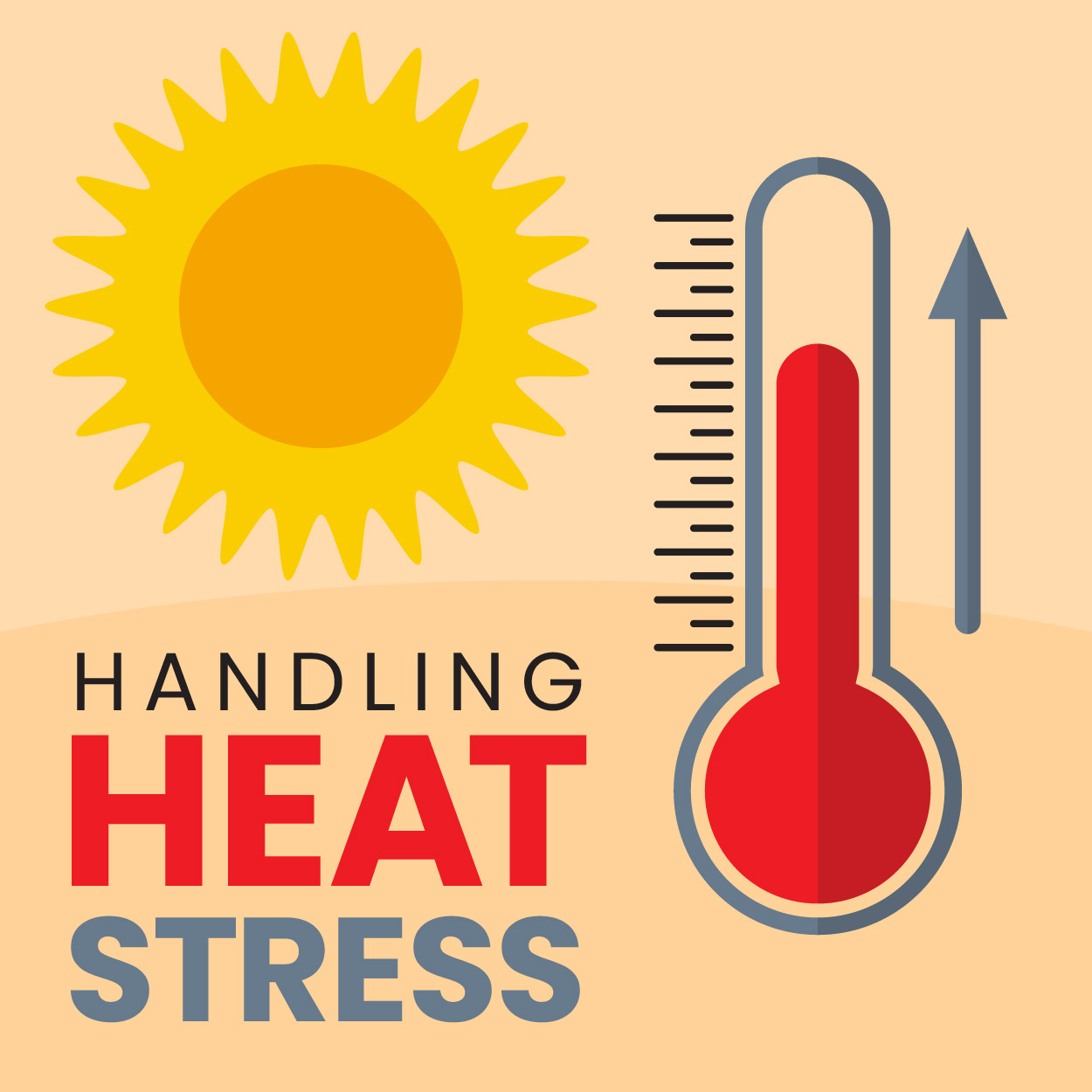
How to Handle Heat Stress Prevention & Training: Spotting Heat Stress Symptoms and More
Heat stress is one of the most dangerous workplace hazards and is a threat to anyone working in hot environments or is otherwise exposed to extreme heat. If affected workers can’t cool down in time, they may start to experience a variety of symptoms that can lead to serious health concerns.
Although millions of U.S. workers are exposed to extreme temperatures, heat stress is often overlooked because it poses less obvious risks than faulty machinery, chemical spills, and scaffolds. In reality, thousands get sick every year from occupational heat exposure. According to the Occupational Safety and Health Administration (OSHA), 50% to 70% of outdoor fatalities occur in the first few days of working in warm or hot environments. This is because the body needs to build a tolerance to heat gradually in a process known as heat acclimatization. A lack of proper acclimatization can put many workers at risk for injuries and even death.
Heat stress does not only happen outdoors. It also affects people who work in the following indoor locations: bakeries, laundromats, kitchens, steel mills, and manufacturing plants with local heat sources such as furnaces, and more.
Symptoms of Heat Stress
Heat stress is an umbrella term for various heat illnesses. As such, heat stress symptoms vary greatly depending on which heat illness you have.
Here are the main heat stress illnesses, from least to most severe.
Heat Rash
Also known as prickly heat, heat rash is the least severe type of heat illness. It will usually go away within a few days.
The symptoms of heat rash are:
- Mild swelling
- A prickly, itchy sensation
- Small, reddish spots
Heat Syncope
Heat syncope is a more severe type of heat stress. It is typically caused by a lack of heat acclimatization and dehydration. It can also happen after prolonged standing and sudden rising from a lying or sitting position.
Symptoms of heat syncope include:
- Dizziness
- Fainting spells
- Light-headedness after standing or sitting
Heat Cramps
Heat cramps are painful muscle spasms that occur as a result of heavy exercise in a hot environment. They are more prolonged and intense than typical muscle cramps.
Symptoms of heat cramps include:
- Flushed, moist skin
- Involuntary jerking movements
- Profuse sweating
- Severe muscle pain
- Fever
Heat Exhaustion
Heat exhaustion typically develops in unacclimated people during tough work sessions on hot days. Without prompt treatment, it can lead to heatstroke.
Symptoms of heat exhaustion include:
- Severe headache
- Muscle cramps or weakness
- Nausea and vomiting
- Profuse sweating
- Weak, rapid pulse
- Moist, cool skin that may have goosebumps in the heat
- Low blood pressure when standing
Heatstroke
Heatstroke is the most severe heat-related illness. It happens when the body is unable to control its temperature. As a result, the body temperature can rapidly rise to 106 degrees Fahrenheit or higher within 10 to 15 minutes. Without emergency treatment, heatstroke can cause permanent disability or death.
Symptoms of heatstroke include:
- Very high body temperature
- Confusion and slurred speech
- Profuse sweating or dry, hot skin
- Coma
- Seizures
How to Prevent Heat Stress
Heat stress is a dangerous work hazard that can lead to fatal injuries and even death if not treated in time. That is why it is crucial for employers and employees to work together to prevent and mitigate heat stress.
Employers
According to the General Duty Clause of the Occupational Safety and Health Act of 1970, employers are required to provide employees with a workplace that is free from hazards that cause or are likely to cause death or serious harm. This includes jobs, tasks, and environments that cause or are likely to cause heat stress.
Although it is tempting to stave off preparing for heat stress until summer, employers should start preparing for heat stress ahead of summer, preferably in spring or even winter. This is because preventing heat stress can take a lot of time and energy, particularly if you do not have a heat illness prevention or training program.
To give you an idea of how extensive heat stress prevention and training programs can be, here’s a summary of what employers have to do to prevent heat stress:
- Create a full-suite heat illness prevention program
- Provide training on what leads to heat stress and how to prevent heat illnesses
- Provide a lot of cool water to employees in or close to the work area. OSHA suggests at least one pint of water per hour
- Modify or create new work schedules that allow workers to take more breaks. Workers should have frequent rest periods with access to cool water in air-conditioned or shaded areas
- Reduce the metabolic demands of a task if workers find it difficult to keep up. Listen to what they have to say and consider increasing the number of workers per task. Consider giving employees ergonomic tools, or tools that are specifically created to reduce manual strain
- Gradually increase workloads as workers get used to the heat
- Give more breaks to workers who are new to the heat until they have acclimatized to the heat
- Assign a responsible person or team to monitor conditions. This will protect workers from developing heat stress symptoms and illnesses
- If the budget allows, buy protective clothing that provides cooling
If an employee is showing symptoms of heat stress, employers need to:
- Call 911
- Have a dedicated person stay with the affected worker until medical personnel arrive
- Move the worker to a shaded or cooler area
- Remove outer layers of clothing
- Mist, fan, and apply ice to the worker to cool down their body temperature
- If the worker is able to drink, give them cool drinking water
Employees
Although employees are entitled to a safe workplace that is free of heat hazards, they should also proactively protect themselves from heat stress. This will further minimize the chances of developing heat stress.
Here’s how you can protect yourself from heat stress as an employee:
- Stay fit. The stronger your cardiovascular system is, the less likely it is that you will develop heat stress symptoms
- Take frequent breaks. Breaks can help your body cool down. If possible, take your break in a shaded area or inside
- Avoid hot areas. When possible, avoid working in the sun during the hottest time of the day (usually between 10 a.m. and 2 p.m.)
- Use sunblock and reapply every two hours
- Stay hydrated. Hydration can stave off many heat stress symptoms and help you stay alert
- Avoid caffeine, energy drinks, and alcohol. These drinks can make you more susceptible to heat illnesses
- Wear lightweight, loose-fitting, long-sleeve shirts and trousers, as well as a hat. This will help your body stay cooler
Heat Stress Training to Implement at Your Workplace
Developing a heat stress training program is critical to protecting your employees and remaining OSHA-compliant.
Training should include the following:
- Information about heat stress; what causes it; what its symptoms are; and how employees, managers, and executives can prevent it
- Proper precautions for working in hot indoor and outdoor areas, such as rest breaks, hydration, and acclimatization
- The effects of over-the-counter medications, caffeine, alcohol, and therapeutic drugs, all of which may reduce heat tolerance and increase the risk of heat illness
- Explanations and demonstrations of the proper use of and care for heat-protective equipment and clothing
Additionally, supervisors should be trained to monitor and respond to weather and workplace conditions.
OSHA Heat Stress Standards
OSHA has also established the following heat stress standards to help employers protect employees from heat stress hazards:
- The personal protective equipment (PPE) standard ( 29 CFR 1910.132(d)) requires general industry employers to conduct hazard assessments to determine the appropriate PPE for protecting employees from the identified hazards.
- The sanitation standards ( 29 CFR 1910.141, 29 CFR 1915.88, 29 CFR 1917.127, 29 CFR 1918.95, 29 CFR 1926.51, and 29 CFR 1928.110) require employers to provide workers with drinkable water.
- The record-keeping regulation ( 29 CFR 1904) requires employers to record certain work-related illnesses and injuries. If an employee suffers a work-related illness or injury and receives days off from work, a job transfer, restricted work activity, or medical treatment beyond first aid, the employer will have to record the case.
- The medical services and first-aid standards ( 29 CFR 1910.151, 29 CFR 1915.87, 29 CFR 1917.26, 29 CFR 1918.97, and 29 CFR 1926.50) require people at the worksite to be adequately trained in first aid. This ensures that injured or ill people get the treatment they deserve if medical personnel can’t get to the worksite on time.
- The safety training and education standard for construction ( 29 CFR 1926.21) require employers to establish and supervise educational and training programs to help employers and employees recognize, avoid, and prevent unsafe workplace conditions.
Hiring a Heat Stress Training Expert
Complying with OSHA’s stringent heat stress standards can be difficult, particularly if you have limited time and energy for creating new standards, protocols, and programs.
That’s why you should partner with YellowBird. We will match you with the perfect heat stress training expert for your workplace in as little as two hours.
Interested in learning more about how YellowBird can help you? Sign up today to get started being safer.





